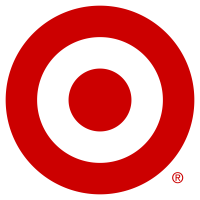- Chart
- Upturn Summary
- Highlights
- Revenue
- Valuation
 Upturn AI SWOT
Upturn AI SWOT - About
Target Corporation (TGT)

- BUY Advisory
- SELL Advisory (Profit)
- SELL Advisory (Loss)
- Profit
- Loss
- Pass (Skip investing)
 Stock price based on last close
Stock price based on last close (see disclosures)
- ALL
- 1Y
- 1M
- 1W
Upturn Advisory Summary
11/05/2025: TGT (1-star) has a low Upturn Star Rating. Not recommended to BUY.
1 Year Target Price $101.36
1 Year Target Price $101.36
| 7 | Strong Buy |
| 3 | Buy |
| 25 | Hold |
| 2 | Sell |
| 0 | Strong Sell |
Analysis of Past Performance
Type Stock | Historic Profit 8.98% | Avg. Invested days 48 | Today’s Advisory WEAK BUY |
Upturn Star Rating  | Upturn Advisory Performance | Stock Returns Performance |
Key Highlights
Company Size Large-Cap Stock | Market Capitalization 41.78B USD | Price to earnings Ratio 10.72 | 1Y Target Price 101.36 |
Price to earnings Ratio 10.72 | 1Y Target Price 101.36 | ||
Volume (30-day avg) 37 | Beta 1.12 | 52 Weeks Range 85.36 - 152.54 | Updated Date 11/5/2025 |
52 Weeks Range 85.36 - 152.54 | Updated Date 11/5/2025 | ||
Dividends yield (FY) 4.98% | Basic EPS (TTM) 8.58 |
Analyzing Revenue: Products, Geography and Growth
Revenue by Products
Product revenue - Year on Year
Revenue by Geography
Earnings Date
Report Date - | When - | Estimate - | Actual - |
Profitability
Profit Margin 3.72% | Operating Margin (TTM) 5.43% |
Management Effectiveness
Return on Assets (TTM) 6.14% | Return on Equity (TTM) 26.32% |
Valuation
Trailing PE 10.72 | Forward PE 11.05 | Enterprise Value 56302267737 | Price to Sales(TTM) 0.4 |
Enterprise Value 56302267737 | Price to Sales(TTM) 0.4 | ||
Enterprise Value to Revenue 0.53 | Enterprise Value to EBITDA 6.55 | Shares Outstanding 454399148 | Shares Floating 452972335 |
Shares Outstanding 454399148 | Shares Floating 452972335 | ||
Percent Insiders 0.26 | Percent Institutions 85.56 |
 Upturn AI SWOT
Upturn AI SWOT
Target Corporation

Company Overview
 History and Background
History and Background
Target Corporation was founded in 1902 as Goodfellow Dry Goods in Minneapolis, Minnesota. It was rebranded as Target in 1962. The company evolved from a regional department store to a national discount retailer, known for its stylish and affordable merchandise.
 Core Business Areas
Core Business Areas
- Merchandise: General merchandise retailer offering a wide assortment of products, including apparel, home goods, food, and electronics.
 Leadership and Structure
Leadership and Structure
Brian Cornell is the Chairman and CEO. The company operates with a functional organizational structure, with key departments such as merchandising, marketing, supply chain, and technology.
Top Products and Market Share
 Key Offerings
Key Offerings
- Apparel & Accessories: Target's private-label apparel brands, such as Cat & Jack and A New Day, contribute significantly to revenue. Competitors include Walmart (WMT) and Amazon (AMZN). Market share within overall apparel is difficult to specifically quantify but it is a significant revenue driver.
- Competitors: Walmart (WMT),Amazon (AMZN),Macy's (M)
- Competitors: Walmart (WMT),Wayfair (W),IKEA
- Home Goods: Target offers a variety of home goods, including furniture, decor, and kitchenware. Competitors include Walmart, Wayfair (W), and IKEA. Market share data varies by subcategory but Target is a significant player in the discount home goods space.
- Competitors: Walmart (WMT),Kroger (KR),Costco (COST)
- Food and Beverage: Target offers grocery items and beverages, including perishables, frozen foods, and packaged goods. It has its own brand Good & Gather. Competitors include Walmart (WMT), Kroger (KR) and Costco (COST).
Market Dynamics
 Industry Overview
Industry Overview
The retail industry is highly competitive and constantly evolving, influenced by factors such as e-commerce, changing consumer preferences, and supply chain disruptions.
Positioning
Target is positioned as a 'cheap chic' retailer, offering a differentiated shopping experience with stylish merchandise at affordable prices. This helps them compete effectively with both traditional discounters like Walmart and department stores.
Total Addressable Market (TAM)
The total addressable market (TAM) for retail in the United States is estimated to be in the trillions of dollars. Target is positioned to capture a portion of this TAM through its focus on general merchandise and its ability to adapt to changing consumer preferences.
Upturn SWOT Analysis
Strengths
- Strong brand recognition
- Loyal customer base
- Effective supply chain
- Attractive store design
- Successful private-label brands
Weaknesses
- Higher prices compared to some competitors
- Reliance on in-store traffic
- Potential for inventory management challenges
Opportunities
- Expansion of online sales
- Growth in urban markets
- Strategic partnerships
- Development of new private-label brands
Threats
- Increased competition from online retailers
- Economic downturns
- Changing consumer preferences
- Supply chain disruptions
- Inflation
Competitors and Market Share
 Key Competitors
Key Competitors
- Walmart (WMT)
- Amazon (AMZN)
- Costco (COST)
Competitive Landscape
Target differentiates itself through its stylish merchandise and enhanced shopping experience. However, it faces strong competition from Walmart, which offers lower prices, and Amazon, which offers a wider selection and convenient online shopping.
Growth Trajectory and Initiatives
Historical Growth: Target has experienced consistent growth in revenue over the past decade, driven by store expansion and e-commerce growth.
Future Projections: Analyst estimates suggest continued revenue growth, driven by digital sales and new store openings. Profitability is expected to improve as supply chain issues are addressed.
Recent Initiatives: Recent initiatives include expanding same-day delivery services, enhancing the online shopping experience, and investing in new store formats.
Summary
Target is a strong brand with a loyal customer base, but it faces increasing competition from online retailers and economic pressures. Their profitability decreased recently but it is recovering. It has responded to these pressures with improvements to the online experience and partnerships with other companies. Strong initiatives include expanding same-day delivery services, enhancing the online shopping experience, and investing in new store formats.
Similar Stocks
Sources and Disclaimers
Data Sources:
- Target Corporation Investor Relations
- SEC Filings
- MarketWatch
- Yahoo Finance
- Company Websites
Disclaimers:
This analysis is for informational purposes only and does not constitute financial advice. Market conditions and company performance are subject to change. Market share values are estimates.
 AI Summarization is directionally correct and might not be accurate.
AI Summarization is directionally correct and might not be accurate.
 Summarized information shown could be a few years old and not current.
Summarized information shown could be a few years old and not current.
 Fundamental Rating based on AI could be based on old data.
Fundamental Rating based on AI could be based on old data.
 AI-generated summaries may have inaccuracies (hallucinations). Please verify the information before taking action.
AI-generated summaries may have inaccuracies (hallucinations). Please verify the information before taking action.
About Target Corporation
Exchange NYSE | Headquaters Minneapolis, MN, United States | ||
IPO Launch date 1983-04-06 | Chairman of the Board & CEO Mr. Brian C. Cornell | ||
Sector Consumer Defensive | Industry Discount Stores | Full time employees 440000 | Website https://target.com |
Full time employees 440000 | Website https://target.com | ||
Target Corporation operates as a general merchandise retailer in the United States. The company offers apparel for women, men, young adults, kids, toddlers, and babies, as well as jewelry, accessories, and shoes; and beauty products, such as skin and bath care, cosmetics, hair care, oral care, deodorant, and shaving products. It also provides food and beverage products comprising dry and perishable grocery, including snacks, candy, beverages, deli, bakery, meat, produce, and food service; electronics which includes video games and consoles, toys, sporting goods, entertainment, and luggage; bed and bath, home décor, school/office supplies, storage, small appliances, kitchenware, greeting cards, party supplies, furniture, lighting, home improvement, and seasonal merchandise; and household essentials, such as household cleaning, paper products, over-the-counter healthcare, vitamins and supplements, baby gear, and pet supplies. In addition, the company sells merchandise through periodic design and creative partnerships, and shop-in-shop experience; and in-store amenities. It sells its products through its stores; and digital channels, including Target.com. Target Corporation was incorporated in 1902 and is headquartered in Minneapolis, Minnesota.

Note: This website is maintained by Upturn Corporation, which is an investment adviser registered with the U.S. Securities and Exchange Commission. Such registration does not imply a certain level of skill or training. Investing in securities has risks. Past performance is no guarantee of future returns. No assurance is provided as to any particular investment return, and you may lose money using our services. You are strongly advised to consult appropriate counsel before making any investments in companies you learn about through our services. You should obtain appropriate legal, tax, investment, accounting, and other advice that takes into account your investment portfolio and overall financial situation. You are solely responsible for conducting due diligence on a potential investment. We do not affect trades for you. You will select your own broker through which to transact. Investments are not FDIC insured, they are not guaranteed, and they may lose value. Please see the Privacy Policy, Terms of Use, and Disclosure for more information.
 Home
Home 
